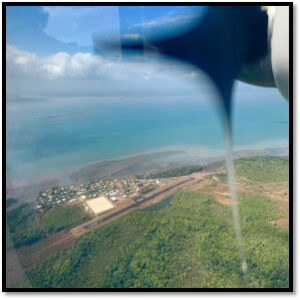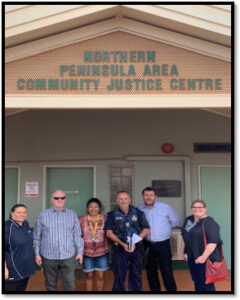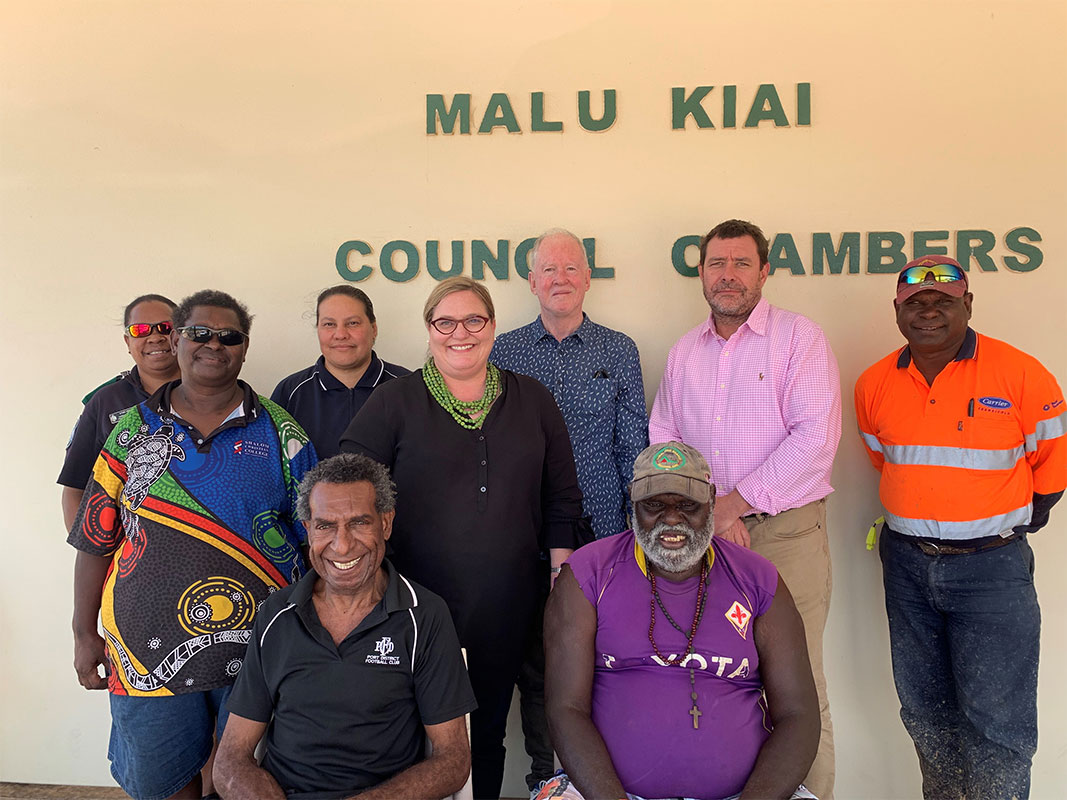Visiting remote communities
The Parole Board goes to Queensland’s top-end
The Torres Strait consists of 18 island and two Northern Peninsula Area communities; and covers an area from the tip of Cape York and north toward Papua New Guinea.
In late September 2019, the President and both Deputy Presidents (the Members) travelled to the top-end of Queensland to visit with several far north remote communities and to engage face-to-face with the people living in the communities and the service providers.
The purpose of the visit was to gain a better understanding of the specific issues facing Aboriginal and/or Torres Strait Islander communities within the region, and to seek feedback and ideas to help the Board improve, and potentially better inform, its decision-making processes.

The four-day trip was a resounding success and saw the Members travel from Cape York on the mainland to as far north as Boigu Island; and to Moa Island and Thursday Island in between.
The connections to country and community were obvious wherever they travelled; as was the commitment, dedication and hard work of the Community Justice Groups operating in those community areas.
What is a Community Justice Group?
In Queensland, a Community Justice Group (CJG) is established under the Aboriginal and Torres Strait Islander Communities (Justice, Land and Other Matters) Act 1984.
A CJG is usually formed when community members come together voluntarily to help reduce crime and social problems in their community area. Their functions include developing networks with agencies and service providers to ensure crime prevention, justice, community corrections and related issues impacting on their community are addressed; and supporting indigenous victims and offenders at all stages of the legal process. The work of a CJG aims to empower their community, at the local level, to address criminal justice issues and to develop strategies designed to reduce the over-representation of Aboriginal and/or Torres Strait Islander people in the justice system.
Nearly all CJG members are volunteers. There is a requirement that membership must, to the greatest practicable extent, include at least one representative of each of the main indigenous social groupings in the community area, and that members must be of good standing in the community. Accordingly, CJGs are comprised of Elders, traditional owners and Respected Persons.
The CJGs visited by the Members
Thursday Island
Thursday Island is about 40 kilometres from the mainland of Australia. It is part of the ‘inner islands’ of the Torres Strait and is accessible only by ferry as there is no airstrip on the Island.
Thursday Island acts as the business and services hub of the Torres Strait region. While there, the Members met with the District Manager and staff at the Thursday Island District Office of Community Corrections and police from the Torres Strait Patrol Group. While the practical challenges of policing and managing offenders on community-based orders across such a large area, comprised mostly of water, was clear, it was also obvious to the Members that the Queensland Police Service and Community Corrections work hard to fulfil their functions in culturally appropriate ways and by fostering relationships with communities.
The Boigu Island CJC
Boigu Island is the most northerly inhabited island off mainland Australia and is one of the closest islands to the border of PNG. It is part of the north-western island group of the Torres Strait; and while very remote, it is accessible by plane and sea.

The Members met with the CJG and the Torres Strait Island Police Support Officers. For this community, movement between Australia and PNG (which is only 6 kilometres away) is common and there is a treaty in place facilitating ease of movement between the two countries. For the Members, this highlighted the need to ensure this unique scenario is contemplated when considering the applications of prisoners returning to Boigu Island; noting that the CJG did not support a move to alter parole conditions to enable such ease of movement for these prisoners.
The CJG also discussed diversionary strategies for parolees living on Boigu Island who start to display the early warning signs of risk of recidivism or non-compliance with parole conditions. For this community, the parolee being sent (in effect, by the CJG) to live in another community area with kinship ties sends a very powerful message to the individual. For this person, it would be considered a punishment and be viewed as an opportunity for them to prove their worthiness to return to the Boigu Island community. This approach would require collaboration and agreement across CJGs in different areas. When raised during subsequent talks with the Kubin Island CJG, they too thought the idea had merit.

The Kubin Island CJG
The Kubin community is on the southern side of Moa Island, which is part of the western island group of the Torres Strait. It is the second largest island and accessible by plane.
The CJG includes a local representative from Queensland Health, the Ranger Service and a Torres Strait Island Police Support Officer; and, like the other communities visited, they were keen to establish a working partnership with the Board to achieve the common goals of community safety and successful return to community for parolees. They were also very interested in working directly with the Board via video-link to provide input to assist in release planning and tailoring of conditions to the parolee.
The Northern Peninsula Area Justice Services ATSI Corp.
The Northern Peninsula Area (NPA), at the tip of Cape York, is comprised of five communities: Seisia, Bamaga, Injinoo and Umagico (each located on the western side of northern Cape York), and New Mapoon (located in the northern most region of Cape York). The NPA is accessible all year; and people often fly direct from Cairns to Bamaga and then drive from Bamaga to the other communities in the NPA. The communities are remote – Telstra mobile phone coverage is available only on Bamaga, parts of Seisia and the Injinoo lookout; and there is a local radio station that runs from a studio in Bamaga which operates on a frequency accessible by the five communities.

The NPA CJG is made up of representatives from the five communities. The Members learned that Seisia and Bamaga are Torres Strait Islander (Saibai) communities, while Injinoo, Umagico and New Marpoon are Aboriginal communities. Sport and recreational activities feature prominently on the Northern Peninsula, in particular local rugby league darbies. There was much talk of the upcoming Grand Final between Injinoo and Bamaga during the Member’s trip. It was identified by the CJG that these initiatives and programs might form part of a parole order and offer a valuable tool in supporting a parolee’s return to the community.
Overarching themes across the community areas
When talking to stakeholders from across the community areas common themes emerged: funding and resources, access to services and release planning for prisoners.
Challenges regarding access to services was a key focus, which is in part reflective of the remoteness of these communities, but also linked to funding and resource considerations. Drug and alcohol, domestic and family violence, and other health services are all based on Thursday Island and the Northern Peninsula. However, the stakeholders advised that from a resource perspective, it is difficult for these services to regularly visit the island communities of the Torres Strait.
The people who the Members met that provide the services to these remote communities are passionate about their work; and are implementing a wealth of ideas and working with the police, councils and other government agencies to focus on a holistic approach to the major issues facing the region. For example, representatives from the NPA Family Resource Centre informed the Members of their ‘one-stop-shop’ offering a range of services including one-on-one domestic violence counselling for men, holistic family support and drug and alcohol counselling. They, and other groups, said that parole conditions that encourage engagement with the Centre (or other programs and activities) would be useful to encourage compliance and reduce any stigma that can attach to counselling.
All the groups noted that planning activities, including employment, and interventions before the person’s release, with parole conditions to reflect this planning, is welcomed.
It was apparent from the four-day trip that communication is the key to developing better ways to keep the communities of the Torres Strait and the NPA safe, while supporting the successful return of their people to community. The CJGs all agreed to trial the use of the video-link facilities to assist in pre-release planning and as a means of bolstering the Board’s decision-making processes.
An update on steps taken since the four-day trip
Video links
Prior to the Member’s visit to the top-end, the officers from the Thursday Island District Office already had effective and successful methods in place for them to liaise and consult with the remote communities, the CJGs and the police regarding the factors relevant to a prisoner’s return to any of these remote communities. However, the added ability of the Board to now communicate directly with the relevant CJGs with regards to the prisoner, has further supplemented the information able to be placed before the Board and thereby enhance its decision-making processes, and ability to structure parole conditions tailored to the individual needs of the prisoner.
A stellar example, on behalf of the Board, of the success of this new process was seen on 1 April 2020 when the Board, led by Deputy President Julie Sharp, in considering a prisoner’s parole application, was informed directly by the NPA CJG and Community Corrections regarding the structuring of additional parole conditions following the receipt of a psychological report commissioned about the prisoner.
In addition to the video link, the Board included a Community Board Member who is an Aboriginal Australian and descendant of the Kombumerri people of the Yugambeh nation whose traditional country covers the Gold Coast and its surrounding areas.
The meeting took place in the midst of the COVID-19 pandemic, so logistically it meant that: Deputy President Julie Sharp was in the Brisbane offices; the other four Board members, who were self-isolating in their homes, teleconferenced into the meeting; the District Manager from Community Corrections appeared by video link from her location on Thursday Island; and the NPA CJG was represented by two of its members by video link from their location in Bamaga. The two CJG representatives brought a wealth of knowledge, experience and expertise to the discussion; one, a community Elder and the other, a dedicated Domestic Violence Court Support Worker, who has comprehensive knowledge of the programs and services available.
This collaboration of stakeholders and agencies represents the strength of the Board’s commitment after its four-day trip.
Conference
Moving forward, the Board is committed to convening a gathering of representatives from each of the region’s CJGs to be held on Thursday Island.
The purpose will be to enable the different community areas to share ideas and experiences in order to develop culturally appropriate case management strategies and justice reinvestment projects; which will, inter alia, help to inform Board decision-making processes and Community Corrections in its management of parole orders.
Prior to the onset of the COVID-19 pandemic, the Board had planned to hold a two to three-day conference in the second half of 2020.
It was hoped that at least two representatives from each of the 18 CJSs in the region would participate; and that discussions could extend beyond parole matters and also include other justice-related topics such as, the operation of the Murri Court and the Courts more generally.
The Parole Board goes to Mt Isa and the Gulf of Carpentaria
In late November 2019, following on from the success of the trip to Far North Queensland, the Members also travelled to Mt Isa and the Gulf of Carpentaria to meet face-to-face with other remote Aboriginal communities and their CJGs.
As had been the experience in Far North Queensland, the strong connections to country and community were obvious; as was the commitment, dedication and hard work of the CJGs operating in those community areas. It was also apparent that the same overarching themes that emerged from the Far North Queensland trip, were also present for these remote communities.
The CJGs visited by the Members

Mornington Island
Mornington Island is an island in the Gulf of Carpentaria, located about 28 kilometres off the mainland of Australia and approximately 440 kilometres from Mt Isa. It is accessible by plane. Mornington Island is renowned for its rich culture expressed through the Mornington Island dancers and their internationally acclaimed artwork.
The CJG emphasised the strong emphasis on community and doing business in the community way, in particular the benefit of mentoring their own people. They highlighted the challenge of a lack of employment opportunities on the Island and the need to develop more reintegration programs that run on the Island itself. The CJG noted that Mornington Island has several funded Men’s Group programs and that a core focus is on the prevention of domestic violence. There are two telehealth facilities that operate well on the Island.
Their remoteness has meant that access to video link facilities is a challenge; and the Members discussed the possibility of exploring the use of Courthouse facilities to enable the CJG to communicate directly with the Board and Community Corrections.

Doomadgee
Doomadgee is on the mainland of Australia in the Gulf of Carpentaria and is located on the Nicholson River. It is approximately 104 kilometres from the border with the Northern Territory, and Mt Isa, which is about 500 kilometres away (or a one-hour flight), is its nearest large town. Doomadgee is accessible by road or plane, having its own airport.
The Members met with representatives of the Doomadgee Aboriginal Shire Council, including the Acting Mayor Jason Ned, and Councillors Vernon Ned, Scharrayne Foster and Dean Jupiter; and the CEO of the Council, Garry Jeffries.
The Councillors highlighted that the Royal Flying Doctors Service has a Domestic and Family Violence Counsellor who is very active in the community; and that there is a well-regarded drug and alcohol service provider who works with the community on a fly-in-fly-out basis.

It was noted for the Members that mining and cattle station work are the two primary employment options for the Doomadgee community. The Gulf Country, including its outstations, covers an approximate area running 50 kilometres north and approximately 40 kilometres wide. The Council is working to establish the ‘On Country Project’ which involves setting up youth camps at various outstations to offer the participants employment doing fencing and other tasks, while at the same time, enabling fellow workers and mentors to help reconnect them to country and community, and restore a sense of culture in the Doomadgee youth. Following the visit, the Board welcomed CEO Garry Jeffries and Councillor Vernon Ned who dropped in for a visit with the Board on 28 November 2019 as part of their trip to Brisbane to discuss the On Country Project with other key stakeholders.
Mt Isa
Mt Isa is the major service centre for North-West Queensland and is situated on the banks of the Leichhardt River, and approximately 900 kilometres west of Townsville. It is accessible by road, train or plane.

The CJG advised the Members that, being the main service hub for the area, there are a wide range of community programs and services available in Mt Isa. However, the overarching challenge for this community is a lack of suitable accommodation for parolees on release, including an absence of crisis accommodation.
An update on steps taken following the remote community visits
Recruitment of more First Nations people as Community Board Members (CBM)
The Board has undertaken a targeted recruitment strategy in consultation with the Department of Aboriginal and Torres Strait Islander Partnerships (DATSIP) to increase the representation of Aboriginal and/or Torres Strait Islander people in the membership of the Board, through its CBMs.
From 1 July 2020 ten new CBMs will join the Board and will further enhance the representation of Aboriginal and/or Torres Strait Islander people.
* Reliance was placed on the following websites regarding the information outlined in this document: www.datsip.qld.gov.au and www.court.qld.gov.au

